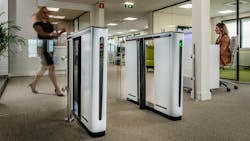The Time is Right for Today’s Advanced Secured Entry Solutions
Archaeologists have concluded that the first recorded reference to doors appeared in Egyptian tomb paintings created somewhere around 3100 BC. The intent then, as it remains today, was simply to keep unwanted visitors from entering a personal or protected space.
The rest of the civilized world caught on to this trend around 2000 BC across Europe and Asia with doors being constructed of many different types of materials ranging from stone to wood and various metals such as bronze.
Fast forward to 1873, when Royal Boon Edam was established in the Netherlands as a carpenter’s shop, eventually evolving to specialize in revolving doors and security entrances.
As Boon Edam looks to celebrate its 150th anniversary in 2023, the design, manufacturing and applications for secured-entry solutions has continued to rapidly evolve – driven by new developments in technology, but also the continued evolution of new and emerging threats, liabilities and risks.
As the list of potential threats grows longer and includes events that can happen faster and be far more dangerous – such as active shooters, workplace violence, terrorist incidents and cyberattacks – these new risks pose real threats, not just to short-term profitability, but for long-term business continuity.
Another factor driving heightened interest in secured entry solutions is coming directly from corporate boardrooms, as corporate executives can and will be held liable for security breaches stemming from a failure to adequately protect people, property and assets. The potential for personal liability has made it easier for security management to plead their case for additional funding to enact more stringent physical security protections – like security entrances.
A Proactive Physical Security Solution
Surveys have documented that the top four threats to an organization’s reputation and brand include workplace violence, an active shooter, terrorism and even cybersecurity -- all of which are exacerbated by the ability of a physical intruder to gain access to the interior of a building.
Security entrances are the only proactive solution that address the risk of unauthorized physical entry through the common practices of tailgating and piggybacking.
Tailgating is perhaps the most common of all physical security entry breaches given the simplicity and often unintended nature of its execution. An employee presents credentials at a swing door, opens it, and politely allows another person to enter.
This basic social engineering scenario exposes a facility to undocumented and unauthorized entry by potentially dangerous individuals. By design, security entrances take the pressure off employees by providing a range of tailgating mitigation assurance levels, from guard assistance all the way up to very high security levels that are effective even when unstaffed.
The second most frequented security offense at facility entry points involves piggybacking, which typically involves the collusion of two individuals attempting to pass through a security entrance at the same time using only one authorized credential.
Selecting the Right Secured Entry Solution
Layering security entrances and sensor technologies provides the best way to maintain the level of throughput specific users need, while establishing high levels of physical access at critical entry/egress points.
Product classifications for security entrances include revolving doors, mantrap portals, optical turnstiles, full height turnstiles and waist height turnstiles and gates. These solutions facilitate a wide range of outcomes, and generally fall into one of three application categories:
1. Prevent tailgating and piggybacking
2. Detect tailgating and piggybacking
3. Deter by monitoring or controlling traffic
Security entrances that Prevent tailgating and piggybacking allow for the elimination or reallocation of guard supervision, providing security and facility managers with tangible ROI. These solutions include revolving doors and mantrap portals, which are virtually impenetrable and prevent unauthorized intrusion.
Also, by collecting metrics gathered by sensor systems in these solutions, security personnel can predict and quantify their actual risk of infiltration. Used often at employee-only entrances and to secure areas containing sensitive data or personnel, these solutions are a breed of security entrances unlike any other.
Security entrances that Detect tailgating and piggybacking provide a strong visual obstacle against intrusion, and when coupled with biometric and access control devices, can detect unauthorized entry attempts in real-time and issue alarms for security personnel to take immediate action.
This category of solutions includes optical turnstiles or speed gates, which are designed to detect tailgating and facilitate both security and visitor management operations. Ideal for reception areas, speed gates can also support regulatory and risk reduction compliance mandates.
Security entrances that Deter unauthorized access serve as a deterrent against casual attempts to gain unauthorized access, and more often are in place to help keep people honest.
They accomplish this by monitoring or controlling traffic under the supervision of security personnel. Appropriate for building perimeters, supervised locations, exit-only applications or any location that needs to control large crowds, these products include full height and waist high tripod turnstiles, wide lane gates and monitored access solutions.
The data collected using overhead sensor systems in security entrances designed to Prevent and Detect threats can also be used as a great new source of business intelligence. The intelligence provided from these devices can help forecast and quantify an organization’s risk of infiltration and threat.
Typically deployed at employee entrances and other sensitive areas within a facility, sensors further elevate the effectiveness and efficiency of security entrances as an enterprise level solution.
The three classifications of security entrances can also be evaluated based on whether they require supervision or can be deployed as stand-alone entry solutions.
Security entrances designed to Deter unauthorized access cannot stop a piggybacking incident from happening on their own, and ideally require manned supervision for proper monitoring.
The cost of supervision should be factored into the annual budget as a necessary expense. If an organization deploys an entrance that requires supervision and elects not to employ personnel to monitor the access point, management could be held liable if an event occurs as a result of their inaction.
Security entrances designed to Prevent and Detect (detect often requires guard oversight, but it may be remote) can be unattended security solutions as they are designed to detect and prevent tailgating and piggybacking. While the initial cost of these solutions is higher, the savings achieved by eliminating or reallocating security personnel provides savings, effectively lowering their total cost of ownership over time.
Key Vertical Market Deployments
The diverse range of security entrances available are designed to accommodate specific entry/egress applications within a facility, which are further differentiated by the type of facility.
For example, logistics and distribution facilities, data centers, and banking and finance institutions are all core vertical markets employing security entrances, but for distinct and different reasons.
Data Centers have their own set of specific needs and challenges, including compliance and customers’ and other technical personnel’s speed of access to servers. Here the need to comply with current regulations such as HIPPA, PCI DSS, FISMA, and Sarbanes-Oxley is mandated and the use of revolving doors and portals, often referred to as mantraps, provide a strong preventive security measure.
When integrated with biometrics such as facial recognition or fingerprint readers, data center operators can realize high ROI by eliminating the need for security personnel supervision, given the ability of biometrics to accurately identify and authenticate individuals without using physical credentials that can be easily lost, stolen or duplicated.
Banking and Financial institutions also face challenges related to fast and easy customer throughput while maintaining high levels of security and compliance. Here security revolving doors can effectively prevent all instances of tailgating and piggybacking into protected areas within a facility, while facilitating two-way traffic.
And for areas with access to vaults and safe deposit boxes, mantrap portals prevent all forms of tailgating and piggybacking to protect people and assets from threats.
Healthcare facilities also experience extremely high volumes of pedestrian traffic throughout the course of the day, every day of the week. The type of individuals entering healthcare facilities falls into one of three general categories: staff, patients and visitors.
To best accommodate and manage pedestrian traffic, healthcare facilities typically employ separate entrances for staff, patients and visitors using a combination of security entrances including, revolving doors for high volume areas like employee entrances, optical turnstiles to manage the flow of access into general visitor and outpatient areas, and mantrap portals to prevent access to high security areas such as operating rooms, nurseries and areas where valuable equipment or pharmaceuticals are stored.
Logistics and Distribution centers use security entrances to control access to keys, goods, and other valuable items. A Fortune 500 logistics customer identified several critical areas for specific security entrances to be deployed across multiple facilities.
These include: the perimeters of buildings, protected by full height turnstiles; initial entry points to buildings, secured using full height turnstiles supplemented by metal detectors and supervised by guard personnel; end of shift exit areas, employing waist-high turnstiles monitored by security personnel; and interior spaces divided by manual revolving doors with opaque doors and panels to eliminate line of sight into executive and high security areas.
Choosing the Right Manufacturer, Installation Partners
It is imperative to partner with a highly experienced and proven security entrance specialist to ensure that you select the most appropriate solution for each location within your facility. The quality and reliability of the security entrances you purchase and install are imperative selection criteria that will help future-proof your investment.
Perform the necessary due diligence when evaluating suppliers and installers, and make sure that the companies you engage have established relationships so you can leverage their combined experience to achieve the best outcomes for your investment.
Valerie Currin has been with Boon Edam for more than 15 years, serving on the executive management team for the past 10 years. Valerie has served as inside sales manager, vice president of product and customer support, vice president of customer experience vice president and national sales manager for the north and east regions of the U.S. as well as Latin America before being promoted to her current role as president and managing director of Boon Edam.

